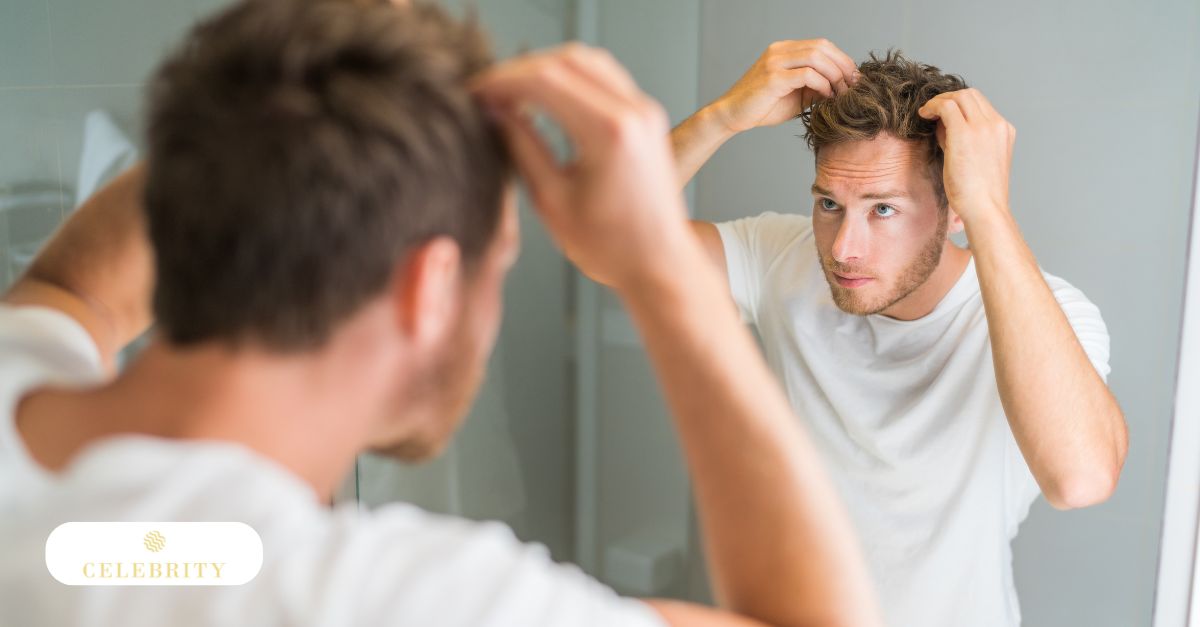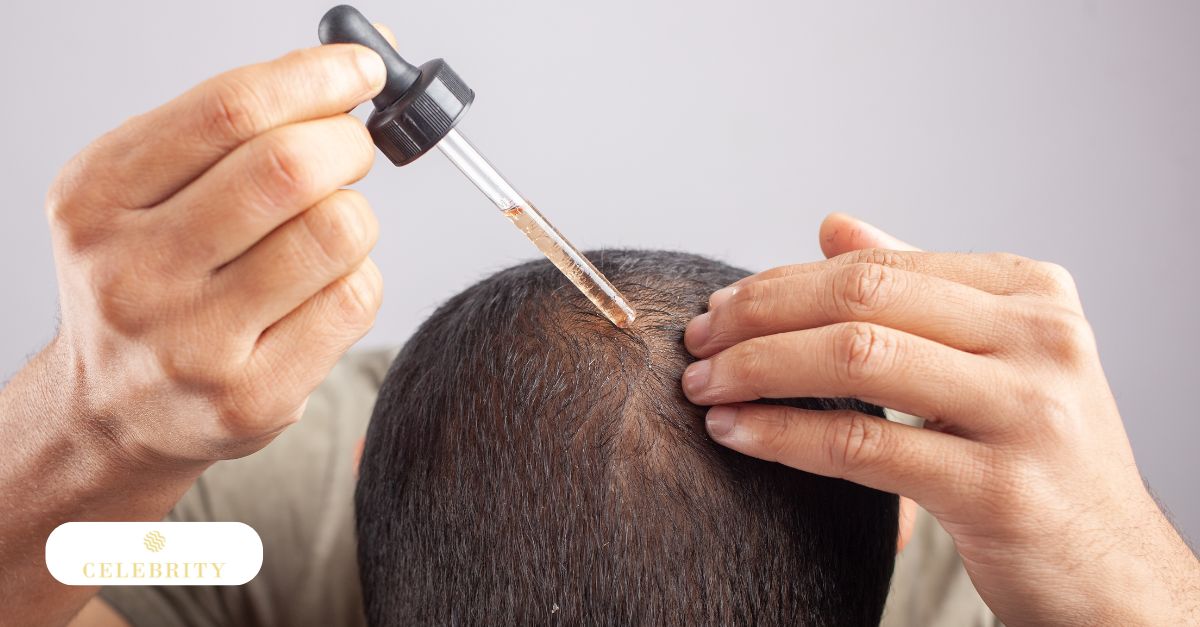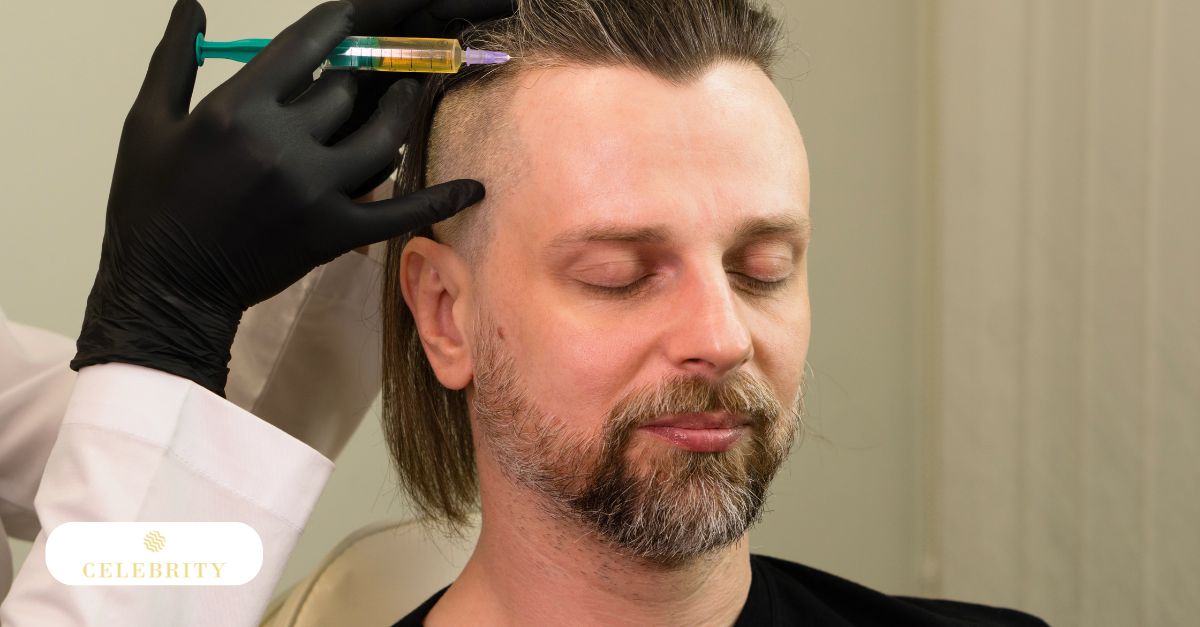Hair loss is a common concern for men, affecting individuals at different stages of life. Whether you’re noticing early signs of thinning or dealing with significant hair loss, various treatment options are available to help restore hair growth and prevent further shedding.
From clinically proven medical solutions like Minoxidil and Finasteride to natural remedies and advanced procedures, this guide covers everything you need to know about hair restoration.
In this comprehensive resource, we’ll explore the most effective treatments for male hair loss, including their benefits, how they work, potential side effects, and suitability for different types of hair loss.
Whether you prefer non-surgical solutions or are considering advanced procedures, this guide will help you navigate the options and find the best solution for your hair regrowth journey.

Common Causes of Hair Loss in Men
Hair loss in men can result from multiple factors. Identifying the underlying cause of hair thinning or baldness is essential for selecting the most effective treatment.
The most common causes of hair loss in men are genetics, hormonal changes, and lifestyle factors. Understanding hair loss causes in men is essential for determining the most effective treatment options. By identifying the root cause, you can better manage and address hair thinning before it progresses.
Genetics: Androgenetic Alopecia
Androgenetic alopecia, also known as male-pattern baldness, is the leading cause of hair loss in men. This hereditary condition typically begins in the early 20s, leading to gradual thinning at the temples and crown. Over time, hair follicles shrink, resulting in finer, shorter strands until they stop producing hair altogether.
Hormonal Changes
Dihydrotestosterone (DHT), a byproduct of testosterone, plays a significant role in hair loss. High DHT levels shrink hair follicles, causing them to weaken and eventually stop producing hair. Men genetically sensitive to DHT are more likely to experience male-pattern baldness.
Lifestyle Factors
Daily habits and overall health also impact hair growth. Factors such as poor diet, chronic stress, lack of sleep, and smoking can negatively affect blood circulation and nutrient delivery to hair follicles, leading to hair thinning over time. Maintaining a healthy lifestyle can help slow hair loss and promote stronger hair growth.
Types of Hair Loss in Men
The two most common types of male hair loss are androgenetic alopecia and telogen effluvium. Understanding which type you are experiencing can help determine the most appropriate course of action for hair restoration.
- Androgenetic Alopecia: The most prevalent form of male hair loss, characterized by a receding hairline and thinning at the crown. This progressive condition is primarily caused by genetics and DHT sensitivity.
- Telogen Effluvium: A temporary form of hair loss triggered by stress, illness, or medication changes. It causes widespread thinning and excessive hair shedding but can often be reversed with lifestyle adjustments and proper treatment.

Medical Treatments for Hair Growth
Medical treatments for male hair loss provide effective solutions to stimulate regrowth and prevent further thinning. These options target hormonal imbalances, follicle shrinkage, and scalp circulation, catering to different stages and types of hair loss.
Minoxidil
Minoxidil is a topical solution applied directly to the scalp and is Health Canada-approved for hair regrowth. It works by stimulating hair follicles and improving blood circulation, promoting thicker, stronger hair growth while slowing hair loss. Results typically become noticeable after 3 to 6 months of consistent use.
Pros
✔ Health Canada-approved and available over the counter.
✔ Stimulates hair follicles, encouraging new hair growth.
✔ Suitable for both men and women.
✔ Non-invasive, with no injections or surgical procedures required.
✔ Affordable and easy to use as a daily topical application.
Cons
✖ Results vary and may take several months to appear.
✖ Continuous use is required—stopping treatment may lead to resumed hair loss.
✖ Potential side effects include scalp irritation, dryness, and unwanted hair growth in unintended areas.
✖ Not effective for all types of hair loss, particularly in advanced cases.
Finasteride
Finasteride is an oral medication that inhibits DHT, a hormone responsible for hair follicle miniaturization. Approved for use in Canada, it is prescribed for male-pattern baldness (androgenetic alopecia) and prostate gland enlargement.
By blocking DHT, finasteride helps prevent further hair loss and can support hair regrowth in men with genetic hair loss. However, results may take several months to become noticeable, and ongoing use is required to maintain benefits.
Pros
✔ Effective for preventing hair loss and promoting regrowth in androgenetic alopecia.
✔ Once-a-day oral medication, making it easy to incorporate into a routine.
✔ FDA-approved and supported by clinical research.
✔ Proven to reduce hair thinning and maintain hair density over time.
Cons
✖ May take 3-6 months or longer to show results.
✖ Possible side effects include decreased libido, erectile dysfunction, and mood changes (though rare).
✖ Not recommended for women, especially those who are pregnant or may become pregnant.
✖ Discontinuing use may cause hair loss to resume over time.
Low-Level Laser Therapy (LLLT)
Low-Level Laser Therapy (LLLT) is a non-invasive hair restoration treatment that uses light therapy to stimulate hair follicles, encouraging regrowth and improved hair density.
As an effective option for non-surgical hair growth solutions, LLLT is often used in combination with other treatments to enhance results. The therapy is safe, requires no downtime, and can be performed at home with Health Canada-approved devices or in-office with professional-grade equipment.
Pros
✔ Non-invasive, painless, and generally free from side effects.
✔ Can be combined with other treatments for enhanced effectiveness.
✔ Health Canada-approved devices available for both home and clinical use.
✔ No recovery time—sessions can be performed with zero downtime.
✔ Beneficial for mild to moderate hair loss and improving hair thickness.
Cons
✖ Results require several months of consistent use.
✖ Effectiveness varies depending on individual hair loss patterns.
✖ Home-use devices may require longer treatment durations compared to in-office sessions.
✖ Higher cost for professional-grade devices and ongoing maintenance sessions.
Are there natural ways to promote hair growth in men?
In addition to medical treatments, natural remedies and lifestyle changes can significantly improve hair health. These methods nourish the scalp, strengthen hair follicles, and support overall hair growth without medical intervention.
Scalp Massages
Regular scalp massages help enhance blood circulation to hair follicles, delivering oxygen and essential nutrients needed for stronger hair growth. A 5- to 10-minute daily massage can:
✔ Stimulate hair follicles, encouraging thicker hair growth.
✔ Reduce stress-related hair loss by promoting relaxation.
✔ Support better absorption of topical treatments like essential oils or Minoxidil.
Tip: Use gentle, circular motions with your fingertips, or consider a scalp massager for deeper stimulation.
Essential Oils
Certain essential oils are known for their hair growth benefits, particularly:
- Rosemary oil – Improves scalp circulation, enhancing hair growth.
- Peppermint oil – Invigorates hair follicles, promoting thicker strands.
Mix a few drops of rosemary or peppermint oil with a carrier oil (such as coconut or jojoba oil) and massage it into the scalp for 5-10 minutes before rinsing.

Nutritional Support
A well-balanced diet rich in vitamins and minerals is essential for maintaining strong, healthy hair. Key nutrients include:
- Biotin – Strengthens hair and improves keratin production. (Sources: eggs, nuts, and sweet potatoes)
- Vitamin D – Supports follicle health. (Sources: salmon, fortified dairy, and sunlight exposure)
- Iron – Prevents hair shedding by improving oxygen delivery to follicles. (Sources: leafy greens, red meat, and lentils)
- Zinc – Helps with tissue repair and hair growth. (Sources: pumpkin seeds, chickpeas, and shellfish)
If your diet lacks these nutrients, consider supplements, but consult a healthcare professional before use.
Stress Management
Chronic stress can trigger telogen effluvium, a condition where hair sheds prematurely. Practicing stress-reducing techniques can protect hair growth:
- Yoga & meditation – Reduce cortisol (stress hormone) levels.
- Exercise – Boosts blood circulation and overall scalp health.
- Adequate sleep – Supports hormonal balance, essential for hair growth.
Prioritizing stress management not only benefits hair health but also improves overall well-being.
Over-the-Counter Products for Hair Growth
Several over-the-counter (OTC) products are formulated to support hair growth, reduce thinning, and strengthen existing hair. These products nourish the scalp and follicles, promoting healthier, thicker hair. Here are some of the most effective OTC options:
Hair Growth Shampoos and Conditioners
Specialized shampoos and conditioners contain active ingredients that help improve hair strength and volume. Key ingredients include:
✔ Biotin – Enhances hair structure and strengthens strands.
✔ Caffeine – Boosts scalp blood circulation, stimulating follicles.
✔ Keratin – Reduces breakage and reinforces hair shafts.
With daily use, these products can improve hair texture and density, making hair appear fuller and healthier.
Topical Treatments
Serums and foams designed for hair growth are another popular OTC option. Many contain Minoxidil, a Health Canada- and FDA-approved ingredient known to stimulate hair follicles and encourage regrowth.
Benefits of Minoxidil-Based Products:
✔ Easy to apply directly to the scalp.
✔ Clinically proven to improve hair thickness.
✔ Best suited for early-stage hair thinning.
These treatments can be combined with other hair growth methods for enhanced results.
Hair Supplements
OTC hair growth supplements provide essential vitamins and minerals to support hair health. While they do not directly stimulate new hair growth like Minoxidil, they strengthen existing hair and improve scalp health.
✔ Biotin – Supports keratin production for stronger hair.
✔ Vitamin D – Essential for follicle health.
✔ Iron – Prevents excessive shedding by improving oxygen delivery to follicles.
✔ Zinc – Aids tissue repair and scalp health.
Supplements work best alongside a nutrient-rich diet and other hair care treatments.
Advanced Medical Procedures for Hair Restoration
For individuals experiencing significant hair loss or seeking faster, long-term solutions, advanced hair restoration treatments may be the best option. These procedures go beyond topical treatments and OTC products, offering intensive, medically-backed solutions for hair regrowth.
Platelet-Rich Plasma (PRP) Therapy
PRP therapy is an innovative, non-surgical procedure that leverages the body’s natural healing properties to stimulate hair regrowth. The process involves:
- Drawing a small sample of the patient’s blood.
- Processing it to concentrate the platelets, which contain powerful growth factors.
- Injecting the PRP solution into the scalp to rejuvenate hair follicles and stimulate new growth.
PRP stimulates collagen production, repairing damaged follicles and promoting thicker, healthier hair.
Clinical research supports PRP’s effectiveness. A randomized, double-blind, placebo-controlled trial with 26 male patients experiencing androgenetic alopecia showed significant hair density improvement within three months of treatment.1
Benefits:
✔ Visible results in 3 to 6 months with improved hair density.
✔ Non-surgical & minimally invasive, making it a low-risk option.
✔ Effective for various types of hair loss, especially androgenetic alopecia.
Considerations:
- Requires multiple sessions for optimal results.
- Maintenance treatments may be needed every 6-12 months.
Hair Transplant Surgery
For those with advanced hair loss or severe receding hairlines, hair transplant surgery offers a permanent solution by relocating healthy hair follicles to thinning or bald areas.
There are two common types of hair transplants:
✔ FUE (Follicular Unit Extraction) – Individual hair follicles are extracted and transplanted.
✔ FUT (Follicular Unit Transplantation) – A strip of scalp is removed, then divided into grafts for implantation.
Benefits:
✔ Permanent, natural-looking results.
✔ Effective for significant hair loss cases.
Considerations:
- Surgical procedure requiring a longer recovery period.
- Higher cost compared to non-surgical options.
Personalized Hair Restoration Solutions
Celebrity Laser & Skin Care offers [advanced hair restoration treatments], including Platelet-Rich Plasma (PRP) Therapy, to help combat hair loss and enhance hair density. Their non-surgical, minimally invasive solutions provide customized treatment plans for long-term hair health.
Take the first step toward hair restoration with expert consultations tailored to your needs.
Pre- and Post-Treatment Care for Hair Growth and Restoration
Following the right pre- and post-care routine is essential for maximizing hair restoration results. The guidelines vary depending on whether you’re undergoing medical treatments (topical or oral medications, laser therapy) or advanced medical procedures (PRP therapy, hair transplants).
Pre-Treatment Guidelines
For medical treatments (Minoxidil, Finasteride, LLLT):
- No special preparation required, but maintaining a healthy diet and scalp hygiene can improve results.
- Avoid excessive alcohol or smoking, as they can impact circulation and hair health.
- For LLLT (laser therapy): Ensure your scalp is clean and free of hair products before sessions.
For advanced medical procedures (PRP Therapy, hair transplant surgery)
- Avoid blood-thinning medications and supplements (Aspirin, Ibuprofen, Vitamin E, Omega-3, Green Tea, Alcohol) for at least 7 days before treatment.
- Refrain from smoking, as it can impair healing and blood circulation to the scalp.
- Stay hydrated and eat a nutrient-rich diet to support hair follicle recovery.

Post-Treatment Guidelines
For medical treatments (Minoxidil, Finasteride, LLLT):
- Minoxidil: Wait 4-6 hours after application before washing your scalp.
- Finasteride: Continue daily use as prescribed; do not stop abruptly.
- LLLT: Follow recommended treatment sessions and avoid excessive sun exposure on the scalp.
For advanced medical procedures (PRP Therapy, hair transplant surgery)
- Avoid washing the treated area for at least 8-24 hours.
- Do not engage in strenuous activities, smoking, or alcohol consumption for at least a week.
- Minimize sun exposure and avoid touching or scratching the scalp.
- Follow all post-care instructions provided by your specialist for optimal healing and regrowth.
Maintenance Sessions
Regardless of the treatment type, maintaining hair health requires consistent care:
- Medical Treatments: Continue use as directed for ongoing effectiveness.
- Advanced Procedures: Schedule follow-up sessions (e.g., PRP every 6-12 months, hair transplant check-ups).
By adhering to the correct pre- and post-treatment care, you can enhance results, minimize side effects, and support long-term hair restoration.
Conclusion
Hair loss can be a frustrating and confidence-shaking experience, but effective solutions are available—from non-surgical treatments and medical therapies to lifestyle changes that support hair health. By understanding the causes of hair loss and the range of treatment options, you can make an informed decision about the best approach for your needs.
If you’re ready to take the next step in restoring your hair and confidence, Celebrity Laser & Skin Care provides expert consultations and personalized treatment plans tailored to your hair regrowth goals.
Book a consultation today and start your journey toward thicker, healthier hair.


